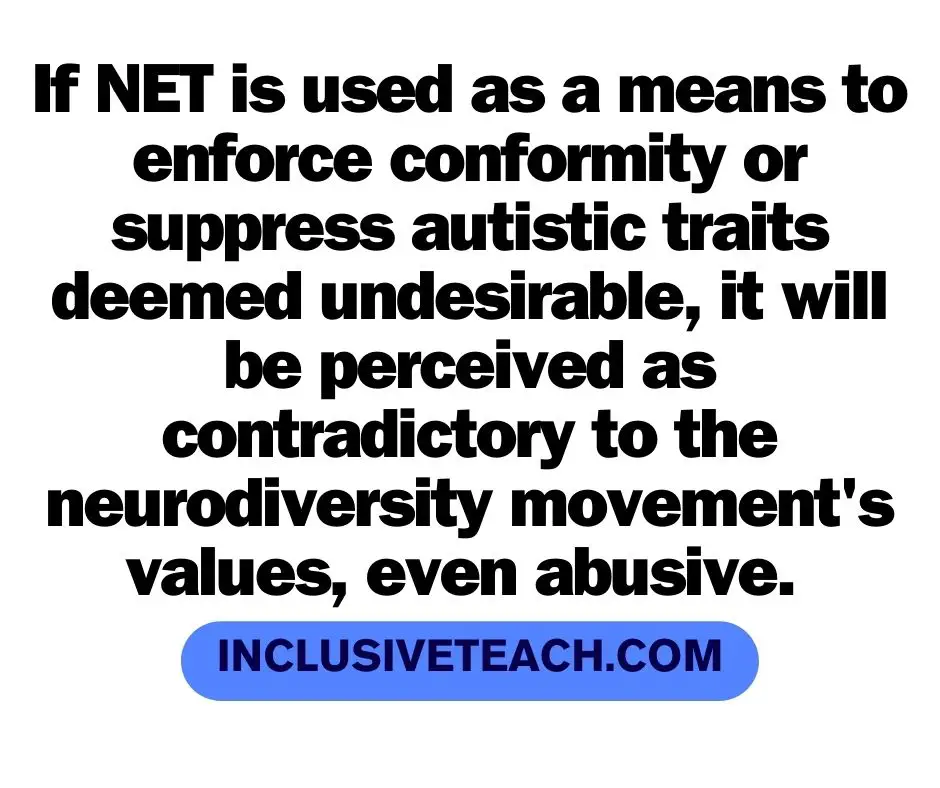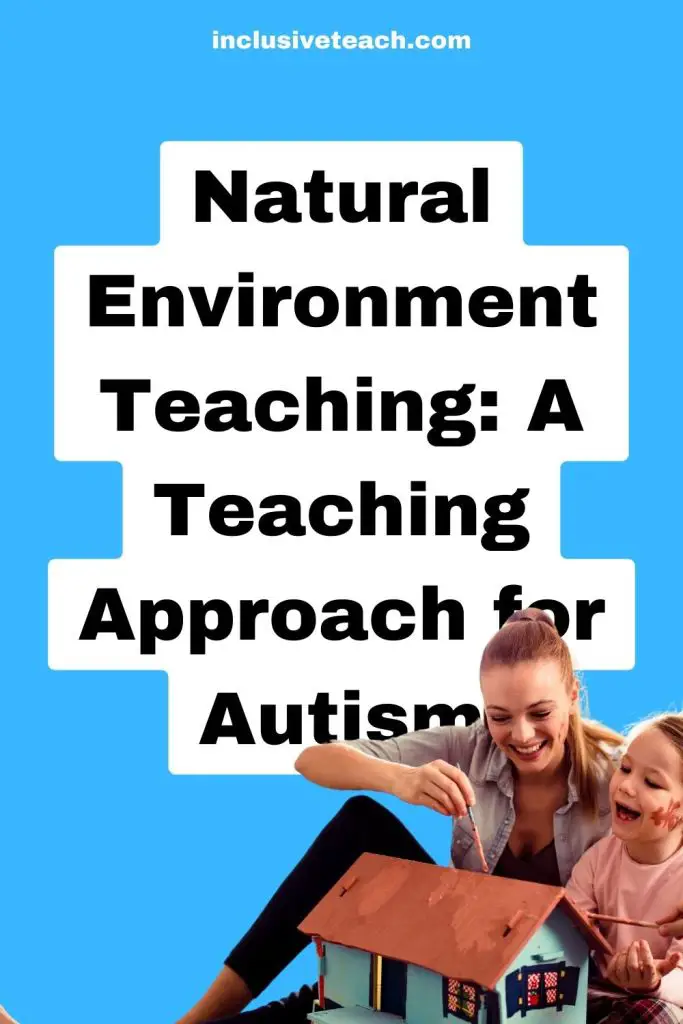Natural Environment Teaching: A Teaching Approach for Autistic Children
What Is Natural Environment Teaching (NET)?
Natural environment teaching (NET), also called naturalistic teaching, is an evidence-based approach within applied behaviour analysis (ABA) therapy. It emphasizes teaching skills in the child’s natural settings and daily routines, aligning with their interests and motivations. Despite its play-based nature, NET is a structured method that effectively targets communication, socialization, and other essential skills. This is not an article supporting the approach but sharing what it is so you can make an informed decision as to whether it is appropriate for your child.

Individualised and Child-Led
NET employs ABA principles tailored to each child’s unique needs and preferences. Unlike the highly structured discrete trial training (DTT), NET offers a flexible, child-led teaching style where the learner’s interests guide the sessions.
Where Does Natural Environment Teaching Occur?
NET can take place anywhere the child naturally spends time – at home, school, playgrounds, or in the community. The key is teaching in familiar environments that align with the child’s typical routines and activities. Many ABA providers offer in-home therapy services to facilitate NET within the child’s most comfortable setting.
Naturalistic Teaching Strategies Used in NET
ABA therapists utilise naturalistic teaching strategies during NET sessions, all designed to promote skill acquisition through the child’s natural interests and motivations. Three primary methods include:
1. Pivotal Response Training (PRT)
Pivotal Response Training (PRT) is a key naturalistic teaching strategy employed within Natural Environment Teaching (NET) sessions. Here’s a more detailed explanation of PRT and how it’s implemented. PRT is based on the idea that targeting certain “pivotal” areas of a child’s development can lead to widespread, collateral improvements across other domains. The four pivotal areas targeted in PRT are:
- Motivation
- Responsivity to multiple cues
- Self-management
- Self-initiations
By focusing intervention on these pivotal areas, PRT aims to produce broader positive impacts on communication, social skills, academic abilities, and reduction in challenging behaviours. Within NET sessions, PRT principles are woven into naturalistic teaching interactions. Here’s how it might be implemented
- Motivation:
- The therapist identifies highly preferred items/activities based on the child’s interests to increase motivation.
- Clear reinforcement contingencies are set up (e.g., if the child requests appropriately, they get access to the desired item/activity).
- Responsivity to Multiple Cues:
- Natural cues and prompts are used to encourage the child to respond (e.g., holding up a desired toy slightly out of reach to prompt a request).
- The therapist varies the cues used, promoting flexibility in the child’s response.
- Self-Management:
- Opportunities for self-monitoring and self-regulation are created (e.g., having the child check off steps in a task, or take a break when overwhelmed).
- The therapist gradually fades prompts to promote independent responding.
- Self-Initiations:
- The therapist follows the child’s lead and interests, reinforcing their initiations and attempts to communicate.
- Environmental arrangements are made to encourage the child to initiate interactions or requests.
Throughout the NET session, the therapist consistently implements PRT strategies by:
- Providing clear reinforcement (access to desired items/activities) contingent on targeted responses.
- Interspersing acquisition and maintenance tasks to build on existing skills while introducing new ones.
- Taking the opportunity to target pivotal areas naturally as they arise during play and daily routines.
- Involving caregivers/family members to promote consistency and generalization of skills.
2. Incidental Teaching
This approach, suitable for children aged 2 to 9, enhances communication by capitalising on the child’s interests and initiations during play or daily activities.
3. Natural Language Paradigm (NLP)
NLP focuses on promoting verbal communication in non-verbal or minimally verbal children. It arranges motivating environments and uses natural cues to encourage language use.

Natural Environment Teaching: Weighing the Benefits and Criticisms
Natural environment teaching (NET), a prominent approach within applied behaviour analysis (ABA) therapy, has garnered both praise, scrutiny and complete rejection from professionals in the field of education for autistic children. While its proponents highlight its numerous benefits, critics raise valid concerns that warrant consideration. I will examine the debate surrounding NET, exploring its advantages and addressing the critiques.
Benefits of Natural Environment Teaching
- Increased Motivation and Engagement: By aligning teaching with the child’s interests and preferences within their natural settings, NET enhances motivation and engagement, reducing disruptive behaviours (through FBA) and promoting a positive learning experience.
- Generalization of Skills: Learning within real-life contexts increases the likelihood of skill generalization across various settings, enabling children to apply acquired skills more effectively in their daily lives.
- Reduced Prompting: NET emphasizes the use of natural cues and environmental arrangements, minimizing the need for excessive prompting and promoting independent skill acquisition.
- Family Involvement: NET actively involves caregivers and family members, empowering them with naturalistic teaching strategies and extending learning opportunities beyond formal therapy sessions.
- Evidence-Based Approach: Numerous research studies have demonstrated the efficacy of NET in promoting skill development, communication, and socialization in children with autism spectrum disorder (ASD).
Criticisms of Natural Environment Teaching
- Lack of Structure: Critics argue that NET’s emphasis on child-led, naturalistic teaching may lack the structure and consistency necessary for effective skill acquisition, especially for children with more significant challenges or those requiring highly systematic instruction.
- Difficulty in Data Collection: Compared to structured approaches like discrete trial training (DTT), NET’s naturalistic setting can make data collection and progress monitoring more challenging, potentially hindering the accurate assessment of skill development.
- Therapist Training Requirements: Implementing NET effectively requires extensive training and expertise in naturalistic teaching strategies, which can be resource-intensive and may lead to inconsistencies in implementation across different therapists or settings.
- Limited Applicability: While NET is beneficial for targeting certain skill domains, such as communication and socialization, critics argue that it may not be as effective for teaching more complex or academic skills, necessitating a combination of approaches.
- Potential for Overgeneralization: Some professionals raise concerns that NET’s emphasis on natural environments and child interests may lead to overgeneralization, where children struggle to transfer learned skills to less familiar or less preferred contexts.
Ultimately, the debate surrounding NET highlights the importance of a balanced and individualized approach to autism treatment. While NET offers numerous advantages, addressing its potential limitations through proper training, progress monitoring, and integration with other evidence-based practices is crucial. Collaborative efforts between professionals, caregivers, and researchers can help refine and optimise NET’s implementation, ensuring that autistic children receive comprehensive and tailored support for their unique needs.
Top Benefits of Natural Environment Teaching
- Child-Led and Engaging: NET prioritizes the child’s interests, increasing motivation and reducing disruptive behaviours.
- Reduced Prompting: Natural cues replace excessive prompting, promoting independent skill use.
- Generalisation: Learning in real-life contexts facilitates generalized skill application across settings.
- Family Involvement: Caregivers can actively participate, extending learning opportunities beyond formal therapy.
- Evidence-Based: Numerous studies demonstrate NET’s efficacy in promoting skill development in children with autism.
Integrating NET into Daily Life
While formal NET sessions with an ABA therapist are crucial, parents and caregivers can reinforce learning by incorporating naturalistic teaching strategies into everyday routines and activities, such as:
- During playtime, following the child’s lead and using incidental teaching
- At mealtimes, using environmental cues to encourage communication
- In the community, capitalizing on naturally occurring opportunities to practice skills
Example Natural Environment Teaching (NET) Session
Setting: The therapy session takes place at the child’s home, specifically in their playroom.
Target Skills: Communication (requesting, labelling) and play skills.
Therapist Preparation: The ABA therapist has prepared a few highly preferred toys/activities based on the child’s interests, such as a bubble machine, building blocks, and a picture book about dinosaurs.
Session Begins:
- Child’s Lead: The child immediately gravitates towards the bubble machine, showing excitement and trying to activate it.
- Incidental Teaching: The therapist follows the child’s lead and interest, using the bubble machine as a context for teaching. “You want bubbles? Show me ‘bubbles’.” (modelling the sign/vocalisation for “bubbles”)
- Reinforcement: When the child attempts to sign or vocalize “bubbles,” the therapist immediately activates the bubble machine as a natural reinforcer, while providing praise and enthusiasm.
- Environmental Arrangement: After a few minutes, the therapist rearranges the environment by placing the picture book out of reach, creating a motivation for the child to request it.
- Pivotal Response Training: As the child shows interest in the book, the therapist prompts, “What do you want?” and waits for the child to initiate a request through vocalization, sign, or gesture.
- Response and Reinforcement: When the child successfully requests the book, the therapist immediately provides it as a reinforcer while offering descriptive praise and encouragement.
- Natural Language Paradigm: During book reading, the therapist points to pictures, pausing to allow the child to fill in labels or descriptions. Natural cues and prompts are used to elicit language.
- Play Skills: The therapist then introduces the building blocks, demonstrating simple constructions and encouraging the child to imitate and explore through play.
Throughout the session, the therapist remains attuned to the child’s interests, adjusting the pace, activities, and level of support as needed. Data is collected on the frequency and quality of the child’s responses, with a focus on capturing naturally occurring skills within the play-based context.
The session concludes by reviewing the child’s progress, highlighting successful moments, and involving the caregiver(s) in discussing strategies for integrating similar naturalistic teaching opportunities into their daily routines at home.
This example illustrates how NET sessions can seamlessly integrate various naturalistic teaching strategies, such as incidental teaching, pivotal response training, and natural language paradigms, within the child’s natural environment and preferred activities. The focus remains on following the child’s lead, using natural reinforcers, and creating opportunities for skill acquisition within authentic contexts.
FAQ about Natural Environment Teaching
Is NET suitable for all children with autism?
NET can benefit many children with autism spectrum disorder (ASD), as it caters to diverse needs and learning styles. However, its effectiveness may vary depending on the child’s specific strengths, challenges, and preferences. An experienced ABA professional can assess the suitability of NET for individual cases.
Can parents participate in formal NET sessions?
Parent involvement is encouraged in NET sessions, as it not only supports the child’s learning but also equips caregivers with naturalistic teaching strategies to reinforce skills at home.
How can you implement NET outside formal therapy sessions?
Incorporating NET principles into daily routines is key. This can include following the child’s lead during play, using environmental cues to encourage communication, and capitalizing on naturally occurring opportunities to practice skills in various settings.
Is Natural Environment Teaching Neurodiversity Affirming?
The question of whether Natural Environment Teaching (NET) is neurodiversity-affirming is an important consideration in the context of autism treatment and support.
Neurodiversity refers to the concept that neurological differences, such as those associated with autism spectrum disorder (ASD), are natural variations in human neurocognitive functioning, rather than disorders or conditions that require a cure. The neurodiversity movement advocates for embracing and accepting these differences while providing appropriate support and accommodations.
In evaluating whether NET is neurodiversity-affirming, we can consider the following aspects:
- Focus on Natural Environments: NET’s emphasis on teaching skills within the child’s natural settings and daily routines aligns with the neurodiversity principle of accommodating and supporting individuals in their authentic environments, rather than attempting to change or “normalise” their behaviour.
- Child-Led and Interest-Based: NET prioritizes the child’s interests, preferences, and motivations as the driving force behind teaching. This approach respects the child’s unique ways of engaging and learning, rather than imposing a one-size-fits-all method.
- Positive Reinforcement: NET heavily relies on positive reinforcement and leveraging the child’s intrinsic motivations, which can be viewed as a strengths-based approach that celebrates and builds upon the child’s inherent interests and abilities.
- Family Involvement: NET actively involves caregivers and family members, empowering them to support the child’s learning and development within their natural environments, fostering acceptance and understanding.
However, it’s important to acknowledge that NET is still rooted in the principles of applied behavior analysis (ABA), which has been subject to criticism from some within the neurodiversity movement. Concerns have been raised about certain aspects of traditional ABA, such as its emphasis on modifying behavior deemed undesirable, the use of aversive techniques (although widely discouraged in modern practice), and the potential for suppressing autistic traits or expressions.
Ultimately, the degree to which NET is considered neurodiversity-affirming may depend on the specific implementation and the broader philosophical approach taken by the therapist and the family. When NET is implemented with a strengths-based, respect-driven approach that celebrates the child’s unique neurocognitive profile and focuses on developing practical life skills while accommodating their authentic needs and preferences, it can be viewed as aligning with neurodiversity principles.
If NET is used as a means to enforce conformity or suppress autistic traits deemed undesirable, it will be perceived as contradictory to the neurodiversity movement’s values, even abusive.
Final Thoughts
It’s crucial for professionals and families to engage in ongoing dialogue, education, and reflection to ensure that NET, and any other intervention or support, is delivered in a manner that respects and affirms the inherent value and dignity of individuals with autism, while providing the necessary tools and resources for them to thrive in a world that embraces neurodiversity.






